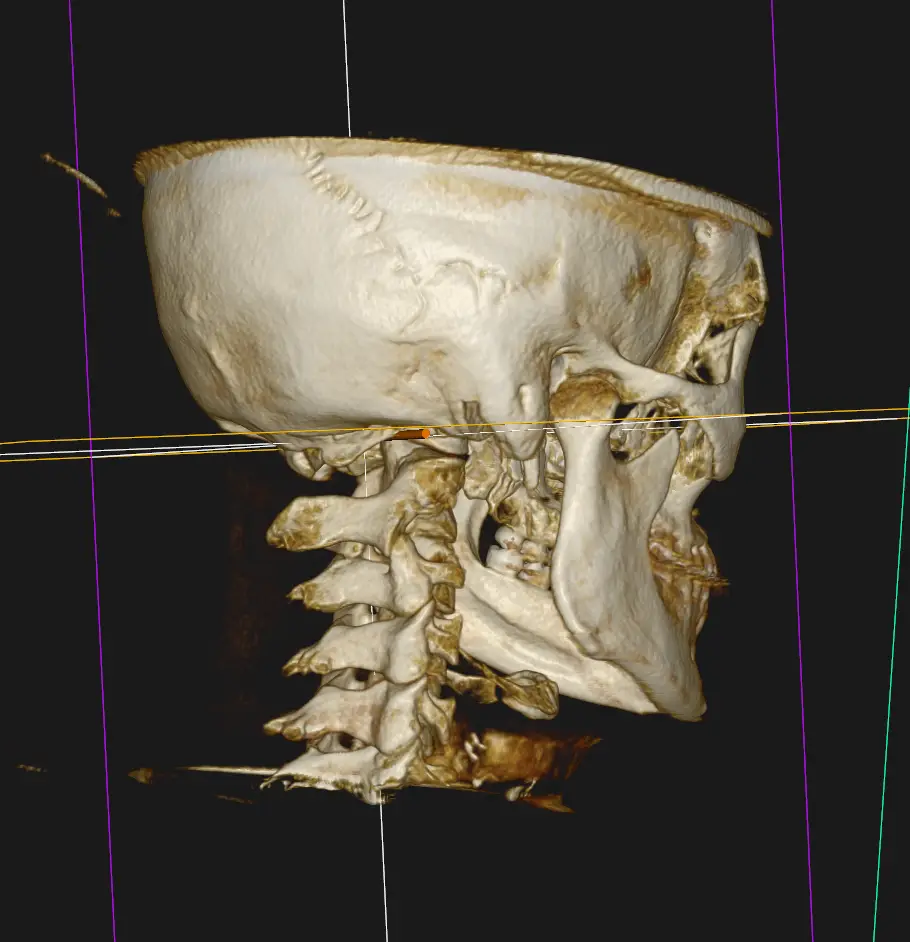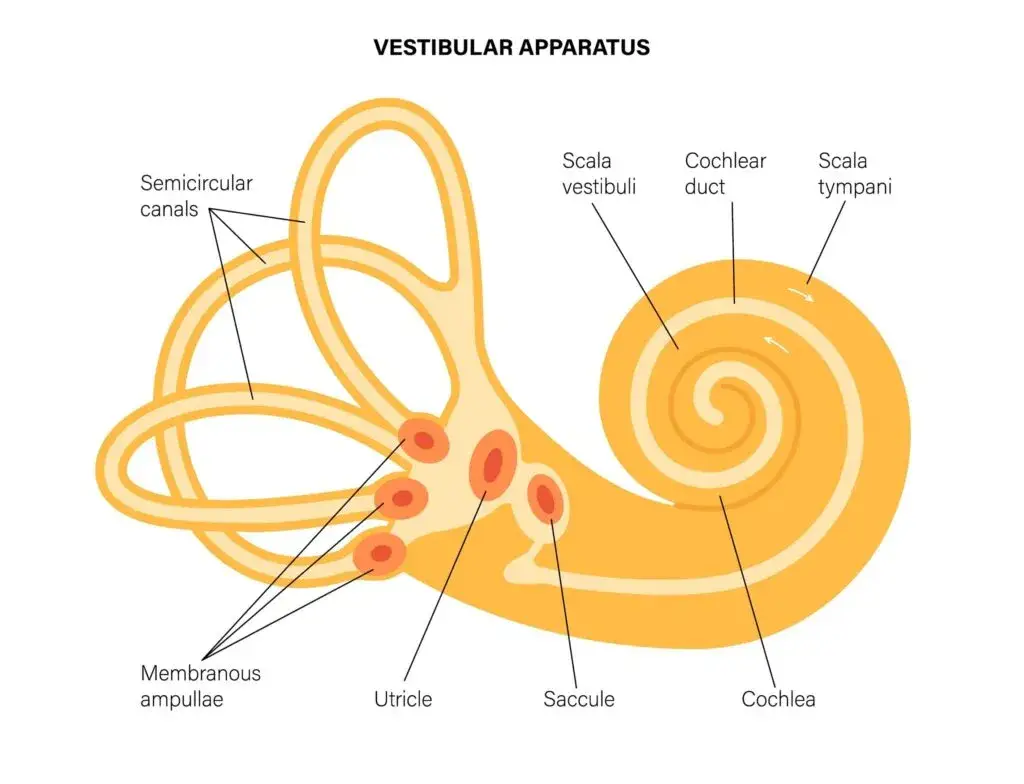
Imaging for Migraines: Migraines steal days, derail plans, and chip away at hope. If you’ve cycled through prescriptions, injections, glasses with tinted lenses, vestibular therapy, or even multiple specialist visits with “normal” scans, you’re not alone. One of the biggest reasons people with migraines—whether classic migraines with aura, vestibular migraines, hemiplegic migraines, tension-type headaches, or cluster headaches—don’t get long-term relief is that the true structural driver of their symptoms is never identified.
At Lavender Family Chiropractic in Sarasota, Florida, we use modern CBCT (Cone Beam Computed Tomography) 3D X-ray imaging to precisely analyze the top of the spine—the atlas (C1) and axis (C2)—and the cranio-cervical junction. When this region is misaligned, it can irritate sensitive neurological pathways that are closely related to migraine physiology. Seeing these small but critical details in three dimensions is often the turning point from confusion to clarity, from chasing symptoms to correcting the underlying problem.
Below, we’ll walk you through why imaging matters for migraine care, how CBCT differs from traditional scans, what we look for in people with different headache types, and how we pair imaging with gentle, precise upper cervical chiropractic adjustments. Our goal is simple: give you a clear, encouraging roadmap to finally move toward lasting relief—without guessing.
Why Imaging for Migraines Matters in Headache Care
If you have migraines, you’ve probably heard some version of “your MRI is normal,” “your CT is clear,” or “we can try a new medication.” While ruling out emergencies is essential, many people never receive a structural explanation for why the migraine pathways keep firing. Migraines aren’t “just headaches”—they’re a complex neurovascular event involving brainstem processing, trigeminal nerve sensitization, blood flow dynamics, and autonomic (fight-or-flight) balance. That’s precisely why a small mechanical problem at the top of the spine can create a big neurological problem in how your head feels.
The upper cervical spine sits directly beneath the skull and surrounds the lower brainstem. The atlas (C1) is a ring-shaped bone that doesn’t have a disc. Instead, it floats between ligaments and muscles, precisely balanced to allow head movement. The axis (C2) forms a pivot. Even millimeter-level shifts here can:
- Irritate or sensitize the trigeminocervical complex, a key relay for head and face pain.
- Influence vertebral artery and venous outflow mechanics, which can modulate migraine patterns.
- Affect cerebrospinal fluid (CSF) flow dynamics at the cranio-cervical junction.
- Disrupt proprioception (your body’s sense of head/neck position), feeding dizziness or visual motion sensitivity.
- Aggravate autonomic tone (sympathetic/parasympathetic balance), fueling light/sound sensitivity, nausea, and cyclic headache patterns.
These shifts are hard to see on 2D films. They’re easy to miss entirely on scans that weren’t taken to evaluate alignment. That’s why CBCT 3D imaging is so valuable: it lets us actually measure the alignment relationships in three planes (front-to-back, side-to-side, and rotational), instead of guessing.
What Is CBCT—and Why It’s Ideal for the Upper Neck
CBCT (Cone Beam Computed Tomography) is a modern 3D imaging technology that uses a cone-shaped X-ray beam and advanced detectors to produce high-resolution volumetric images of the head and neck. Originally adopted in dental and maxillofacial fields, CBCT has become a powerful asset in upper cervical chiropractic because it shows the cranio-cervical junction with exceptional clarity and accuracy.
Key Advantages of CBCT for Migraine Patients
- True 3D, Multi-Planar Visualization: We can analyze C1 and C2 alignment in coronal, sagittal, and axial planes, plus create customized slices through any angle we need.
- Fine Detail for the Atlas/Axis: The atlas ring, lateral masses, and the odontoid (dens) are visualized in great detail, making small rotational or tilting misalignments easier to quantify.
- Efficient and Comfortable: Most scans take under a minute. There’s no tunnel, no loud noise, and minimal motion constraints.
- Focused Purpose: CBCT is optimized for bone and alignment. It doesn’t replace MRI for soft-tissue questions (brain tissue, acute stroke, etc.), but it excels at the structural analysis we need to guide precise corrections.
- Modern Radiation Protocols: Contemporary CBCT units utilize protocols designed to keep dose low while maintaining diagnostic quality. For many patients, the benefit of finally seeing the cause of their migraines far outweighs the small exposure.
At Lavender Family Chiropractic, CBCT is not a “nice to have.” It’s a cornerstone of how we create precise, individualized care plans for people with migraines, headaches, dizziness, and balance problems.
How CBCT Guides Care for Different Headache and Migraine Types
Every headache label describes a pattern, but it doesn’t always reveal the source. CBCT helps us connect the pattern you feel with the structure we can correct.
Migraines with Aura
Visual disturbances (flashing lights, blind spots, zig-zags) often precede the headache. While auras are generated centrally, mechanical irritation at the upper cervical spine can add fuel to the fire by increasing brainstem sensitivity and autonomic reactivity. On CBCT we look for:
- Rotational atlas misalignment that loads one side of the cranio-cervical junction.
- Side-bending (lateral tilt) patterns that correlate with head posture asymmetry.
- C2 body rotation that pairs with unilateral trigeminal referral patterns.
Addressing these alignment issues can reduce the frequency or intensity of aura-linked attacks by calming the upstream triggers.
Vestibular Migraines
Dizziness, vertigo, rocking, and motion sensitivity can be profoundly disabling. The vestibular system blends input from your inner ears, eyes, and neck. A misaligned atlas can corrupt the “neck” part of that equation, forcing your brain to reconcile conflicting information. On CBCT we evaluate:
- C1’s relationship to the foramen magnum (where the brainstem exits).
- The atlas’ lateral masses for asymmetry that mirrors head tilt.
- C2 rotation patterns that align with ocular motor complaints or nausea.
Paired with functional nervous system scans in our office, CBCT becomes a roadmap for restoring normal sensorimotor integration—often the missing piece for people told their tests are “fine.”
Hemiplegic Migraines
This rare subtype mimics stroke with temporary weakness or numbness on one side. Emergency medical care always comes first. After clearance, we use CBCT to determine whether significant cranio-cervical imbalance is repeatedly priming the system. We assess:
- Severe rotational malposition that may influence vertebral artery mechanics.
- Atlas miscentering beneath the skull that increases local irritation.
- Longstanding tilt patterns that match post-injury histories (falls, car accidents, sports concussions).
Our adjustments are gentle and specific—no twisting or cracking—prioritizing stability and neurological calm.
Tension-Type Headaches
Often described as a tight band or pressure, these headaches are frequently blamed on muscles alone. But muscles respond to alignment. If C1/C2 alignment is off, deep suboccipital muscles tighten to protect the area, pulling on the scalp and amplifying scalp/forehead pressure. CBCT shows whether the “muscle problem” is actually a mechanical alignment problem first.
Cluster Headaches
Cluster headaches can be excruciating and cyclical, often accompanied by tearing, nasal congestion, or agitation. They’re complex, but brainstem and autonomic involvement are central. CBCT can reveal stubborn cranio-cervical patterns that perpetuate autonomic imbalance. Reducing noxious input at the top of the neck may lower the “baseline drive” behind cluster activity for some patients.
Chronic Daily Headache / Post-Concussion Headache
When headaches become daily—or follow a concussion—CBCT helps us determine whether the impact shifted the atlas enough to keep the system in a sensitized state. Many post-concussion patients have normal brain MRIs but abnormal upper cervical alignment that keeps the head/neck system “on edge.” Correcting this alignment can help other therapies begin to stick.
The Upper Cervical Connection: Why Millimeters Matter
The atlas (C1) is the most mobile bone in your spine. Its job is to hold up your head while letting you nod and turn with ease. Because it floats between ligaments and muscles, it can lose its neutral position after even minor trauma or long-term postural stress. When that happens:
- Trigeminal Sensitization: The trigeminal nucleus caudalis integrates neck and facial inputs. Irritation here helps explain why neck issues can refer as eye, forehead, or temple pain—and why light/sound can feel intolerable during attacks.
- Autonomic Dysregulation: The brainstem modulates heart rate, breathing, pupil size, and gut motility. Irritation can tip the scales toward sympathetic dominance (fight-or-flight), fueling migraine triggers like poor sleep, stress reactivity, and nausea.
- Vascular/CSF Mechanics: Subtle misalignment can influence venous drainage or CSF flow at the cranio-cervical junction, interacting with pressure sensitivity patterns reported by many migraineurs.
- Proprioceptive Chaos: If neck sensors report a head position that doesn’t match eye/inner-ear input, the brain becomes overloaded—leading to dizziness, motion intolerance, and visual blurring.
Because all of this lives at the intersection of structure and neurophysiology, careful 3D imaging is vital. Guessing isn’t good enough. Measuring is.
What to Expect at Lavender Family Chiropractic (Sarasota, Lakewood Ranch, Bradenton)
1) Thoughtful Consultation
We take time to hear your story: age at onset, concussion or whiplash history, hormonal or weather triggers, visual motion sensitivity, brain fog, GI sensitivity, and medication history. Migraines are personal—so is our intake.
2) Functional Nervous System Scan (Tytron)
Our paraspinal infrared thermography (Tytron) evaluates heat/nerve interference patterns that correlate with autonomic activity along the spine. This objective scan, paired with posture and range-of-motion tests, helps us see how your nervous system is functioning right now.
3) CBCT 3D Imaging
We perform a targeted CBCT of the cranio-cervical region. You’ll be comfortable and still; the scan is quick. We reconstruct the images to evaluate atlas/axis orientation, tilt, rotation, and centering. We correlate these findings with your symptoms (for example, right-sided eye pain with right atlas rotation).
4) Precise, Gentle Upper Cervical Adjustment
We deliver a tailored, low-force correction—no popping, twisting, or cracking—crafted from your CBCT measurements. The goal is to restore alignment and ease pressure on neurological structures. Many patients describe a wave of calm or clarity after the first corrective visit.
5) Re-Checks and Progress Markers
We track progress using symptom diaries, Tytron scans, posture photos, and if clinically indicated, follow-up imaging. Stability is the goal: fewer attacks, lower intensity, shorter duration, and greater resilience to common triggers like barometric pressure shifts, screen time, or busy travel days.
Common Questions About CBCT vs. MRI vs. Standard X-Rays
- Does CBCT replace MRI? No. MRI is for soft tissue, brain structures, and acute neurological concerns. CBCT excels at bone and alignment—exactly what we need to correct the mechanical drivers of many migraine patterns.
- Why not use regular X-rays? Two-dimensional films compress depth and can hide small rotational or side-bending errors. CBCT gives us a true 3D map, so we know exactly how to correct you.
- Is CBCT safe? Modern CBCT systems use refined protocols to keep dose low. We image only what we need, and only when we need it.
- How often is CBCT repeated? Typically at the start of care and then only if clinically necessary (for example, after a new injury or if alignment doesn’t stabilize as expected).
Real-World Stories (Names Changed for Privacy)
“S.” from Lakewood Ranch – Vestibular Migraine
Years of rocking dizziness and nausea made shopping and driving terrifying. Brain MRI was normal. CBCT showed a right atlas rotation with slight tilt. After specific upper cervical corrections, her dizziness episodes shortened, then faded. She now drives confidently and works full days again.
“M.” from Sarasota – Cluster Headache
Pain behind the eye in cycles, extreme agitation, tearing—nothing helped. CBCT found a stubborn cranio-cervical imbalance with C2 rotation. As alignment stabilized, his cluster cycles grew less intense and less frequent. He describes it simply: “I got my life back.”
“E.” from Bradenton – Hemiplegic Migraine
Scary weakness on one side sent her to the ER twice. Emergencies were cleared; MRI normal. Our CBCT revealed marked atlas translation. Gentle care reduced attack frequency, and her family finally exhaled.
While every person is unique and results vary, these cases illustrate a theme: when you see the structure clearly, you can finally correct it precisely.
Who Should Consider CBCT 3D Imaging for Headaches and Migraines?
- People with recurrent migraines, especially with neck stiffness or a history of whiplash/concussion.
- Anyone with vestibular symptoms—dizziness, vertigo, rocking, visual motion sensitivity—either standalone or as part of migraine.
- Patients with aura, facial pain, eye pain, or jaw tension (TMJ) that accompanies their headache cycle.
- Those with tension-type headaches that resist standard care or keep recurring despite massage, stretching, or medication.
- Individuals with cluster headaches seeking a comprehensive, structural review of the cranio-cervical junction.
- People who’ve been told “your scans are normal,” but know something mechanical is still wrong.
What Improvement Looks Like When the Upper Neck Is Corrected
- Less frequent attacks and shorter duration when they do occur.
- Lower intensity—from debilitating to manageable to occasional.
- Fewer triggers and better resilience to weather changes, travel, screen time, and stress.
- Calmer nervous system—improved sleep, fewer GI flares, steadier energy.
- Better balance and clarity—less dizziness, less visual motion sensitivity, clearer thinking.
- Confidence and control—the most meaningful outcomes aren’t just on a chart; they’re in your everyday life.
Safety First (Important Notes)
- If you develop new neurological symptoms (sudden severe headache, weakness, speech or vision changes), seek emergency care. MRI/CT may be appropriate to rule out acute conditions.
- CBCT is targeted for bony alignment. It’s not a brain scan and doesn’t replace medical evaluation for non-mechanical causes.
- Our approach is collaborative. We routinely co-manage with neurologists, ENTs, primary care providers, vestibular therapists, and dentists when needed.
Top 15 FAQs: Imaging for Migraines & Upper Cervical Chiropractic
- Is CBCT safe?
Modern CBCT uses focused, low-dose protocols. We scan only what’s necessary to answer specific alignment questions. - How long does the scan take?
Typically under a minute, start to finish. - Will I feel anything during CBCT?
No—it’s noninvasive and painless. - Can CBCT find brain tumors or strokes?
No. CBCT images bone and alignment exceptionally well. For brain tissue questions, MRI/CT via your medical team is appropriate. - Why is CBCT better than regular X-rays for migraines?
Migraines often involve tiny atlas/axis misalignments that are hard to appreciate in 2D. CBCT provides true 3D detail, which improves precision in your correction. - What if my MRI was normal?
That’s common. MRI asks a different question (soft tissue). CBCT asks, “Is the cranio-cervical alignment normal?” Those answers can be very different—and clinically crucial. - How often do I need a CBCT?
We typically scan at the beginning of care. If you have new injuries or your case requires, we may repeat selectively. - Is the adjustment forceful?
No. Our upper cervical chiropractic corrections are gentle, specific, and tailored from your CBCT data—no popping, twisting, or cracking. - How quickly will I notice changes?
Some feel lighter or clearer right away; others improve steadily over weeks as stability builds. Our progress markers (symptom logs, Tytron scans, posture checks) keep us objective. - Can CBCT help vestibular migraine and dizziness?
CBCT doesn’t “treat” dizziness; it identifies misalignments that can drive vestibular mismatch. Correcting those often reduces dizziness significantly. - What about cluster headaches?
While clusters are multifactorial, calming brainstem/autonomic irritation by restoring upper cervical alignment can make a meaningful difference for some patients. - Do you work with my other providers?
Absolutely. We collaborate with neurologists, ENTs, primary care, and therapists as needed. - Is CBCT covered by insurance?
Our office is out of network with insurance. Many of our patients receive a superbill to submit to their insurance for reimbursement based on their coverage. We offer many different payment options as well as finance options. - What if I’m nervous about imaging or chiropractic care?
We’ll walk you through every step, show you your images, and explain the plan in plain language. Comfort and consent come first. - Why choose Lavender Family Chiropractic?
Because we combine state-of-the-art CBCT, Tytron functional nervous system scans, and precise upper cervical chiropractic—plus a caring, three-doctor team—to help you finally address the root cause instead of just chasing symptoms.
SEO Note: Who We Help and Where We Serve
People often find us while searching chiropractor Sarasota Florida, chiropractor near me, upper cervical chiropractor near me, upper cervical chiropractic, Vertigo doctor near me, or Migraine doctor near me. If that’s you, we serve patients across:
Sarasota, Bradenton, Lakewood Ranch, Parrish, Ellenton, Venice, Osprey, Punta Gorda, St. Petersburg, Siesta Key, Longboat Key, Lido Key, and Myakka City.
Your Next Step: A Clear Plan, Not Guesswork
Hope thrives when there’s a plan. At Lavender Family Chiropractic, we don’t ask your nervous system to change blindly—we show it the way with precision imaging and gentle, targeted correction. If you’ve felt stuck or dismissed, please know: there is more to see, and there is more we can do.
- We listen to your full story.
- We measure with Tytron and CBCT.
- We correct gently and precisely.
- We track objective progress, aiming for real-world wins: fewer attacks, less dizziness, more life.
If you’ve been told your scans are “fine” but you still don’t feel fine, a focused look at the upper cervical spine may be the missing link.
About Lavender Family Chiropractic
Lavender Family Chiropractic is a leading upper cervical chiropractor in Sarasota and the greater Southwest Florida region. We specialize in complex cases: migraines (with and without aura), vestibular migraines, hemiplegic migraines, tension-type headaches, cluster headaches, post-concussion syndrome, TMJ-related headaches, and stubborn dizziness. Patients choose us for our state-of-the-art CBCT 3D imaging, functional nervous system scans (Tytron), and gentle, precise adjustments—all designed to restore stability at the top of the spine and calm the brainstem.
Our three-doctor team—Dr. Rusty Lavender, Dr. Jacob Temple, and Dr. Will Guzinski—is committed to clarity, compassion, and measurable results. We’ve helped thousands of neighbors across Sarasota, Bradenton, and Lakewood Ranch reclaim their days from head pain and dizziness.
Call to Action
If you’re ready to see what others have missed, schedule your CBCT-guided upper cervical evaluation today.
Lavender Family Chiropractic in Sarasota Florida offers complimentary consultations to learn more about you. Click the link below!
https://intake.chirohd.com/new-patient-scheduling/724/lavender-family-chiropractic
Visit our Website!
To learn more about us go to http://www.chiropractorsarasotaflorida.com
We also service Bradenton, Parrish, Ellenton, Ruskin, Venice, Tampa, St. Pete, Osprey, Longboat, Lakewood Ranch, Myakka City.
If you are in Tampa, Fort Myers, or Salt Lake City, you can visit my other locations! NeckWise Upper Cervical. Visit, www.neckwise.com
If you are not local, visit www.uccnearme.com to find a doctor in your area.
Serving Sarasota, Bradenton, Lakewood Ranch, Parrish, Ellenton, Venice, Osprey, Punta Gorda, St. Petersburg, Siesta Key, Longboat Key, Lido Key, Myakka City and beyond.
- Address: 5899 Whitfield Ave Ste 107, Sarasota, FL 34243
- Phone: (941) 243-3729
- Website: www.chiropractorsarasotaflorida.com
- Instagram: @lavenderfamilysrq
- TikTok: @drrustylavender
When you’re searching “chiropractor near me”, “upper cervical chiropractor near me”, “Vertigo doctor near me”, or “Migraine doctor near me”, we’re here to help you find lasting relief—by seeing the problem clearly and correcting it precisely.
Final Encouragement
You are not broken. Your migraines are not a mystery without a map. With CBCT 3D imaging and upper cervical chiropractic, we can finally line up what you feel with what we see—and build a personalized plan that brings your nervous system back to calm. Whether you’re navigating vestibular migraines with dizziness and imbalance, classic migraines with aura, hemiplegic episodes that frighten your family, tension-type pressure, or the cyclical storm of cluster headaches, you deserve a team that looks deeper and treats you like the whole person you are.
Clarity first. Then correction. Then confidence. That’s the path we walk with you—step by steady step—at Lavender Family Chiropractic.





